Click here to see video
Ethernet cables and phone lines cover her kitchen counter. No cordless phones, no WiFi.
"This is tobacco all over again," Marks says, "This industry, my colleagues and I think, is worse than the tobacco industry."
Marks believes radiation from the most common, even beloved technology, nearly killed her husband. Alan was diagnosed with Glioma, a type of tumor that starts in the brain or spine. In this case, malignant.
One night in 2008, her husband Alan suffered a grand-mal seizure. That same month, Senator Ted Kennedy suffered the same seizure and received the same diagnosis. Mark's son worked in Senator Kennedy's office at the time. She says her son told her something that changed her life.
"He said the Kennedys are talking about it being Ted's cell phone use," Marks recalls. "I was flabbergasted. I'll never forget the feeling. I thought I was going to faint. I thought that can't be, look at all the people using cell phones."
Marks began devoting her life to researching the health effects of cell phones, speaking with leading oncologists and radiologists from around the world and here in California, and testifying before congress on the effects of cell phone use on the body.
The CDC, FDA, and the National Institute of Environmental Health Sciences state studies linking health hazards to cell phone radiation are inconclusive.
The Federal Communications Commission admitted in an investigation with the Government Accountability Office, it does not test mobile phone use against the body -- for example, when held up to the head -- and that could result in radio-frequency, or RF, exposure, higher than the FCC limit.
"These were never pre-market safety tested, industry has no liability insurance, so they can't let the cat out of the bag, and we are exposing a whole generation of kids and teens to wireless radiation," says Marks.
In 2011, the World Health Organization gathered leaders on the issue, spending two weeks compiling tests and studies. The results are must different than that of the US government.
"The WHO International Agency for Cancer has classified radiofrequency electromagnetic fields as possibly carcinogenic to humans based on an increase for glioma, a malignant type of cancer-based on wireless phone use," reads Marks.
The argument is that radiation penetrates the blood-brain barrier in our heads. Over time, that barrier diminishes leading to head and neck cancer. Other doctors argue this is not limited to the head -- leading to breast cancer in women who keep phones in their bra and reproductive problems in men who keep phones in their pocket.
While the evidence is documented as inconclusive, there are currently two large research studies that hope to give the WHO a more definitive stance in the coming years.
COSMOS is testing nearly 300 thousand cell-phone users through the years 2020 and 2030. Another study already under way is a case-control study called Mobi-Kids exit disclaimer, which will include 2,000 young people with newly diagnosed brain tumors and 4,000 healthy young people. The goal of the study is to learn more about risk factors for childhood brain tumors. Results are expected in 2016.
Marks is now the leader of the California Brain Tumors Association.
While forming the education and support foundation, she met glioma victims and survivors from around the state, including Daphne Jasperse of Palm Desert. Doctors diagnosed her husband, Steve, with glioma the same year as Ellie's husband Alan. Steve died eight months later.
"Steve was a contractor, so he had these big battery phones in 1988 when he started," Jasperse says, "and one of his bosses called him cauliflower ear because he was constantly on his phone."
It's hard to imagine giving up our phones altogether. Take a moment to check your cell phone manual. Most iPhones say the phone should be about an inch away from the body.
So what can we do to protect against potentially deadly cell phone radiation?
Dr. Joel Moscowitz, Director at the UC Berkeley Prevention Research Center, says retro-looking, connected plastic handsets are the best way to talk on the phone, if not on speaker and away from the body.
"I've had engineers look at this and they say it's a lot safer," says Marks. Both she and Jasperse carry them in their purses.
"It brings up a conversation," Jasperse says. "People say well, is that for real? Why are you doing that? I say my husband died of a brain tumor and I really believe it was his cell phone. Please don't hold your phone to your ear."
Cary Subel created SafeSleeve. He claims these laptop and phone cases significantly cut back radiation.
Specific Absorption Rate (SAR) is the amount of radiation the brain is absorbing while the phone is near the head. SAR must be tested in a controlled environment, as to avoid radiation interference from things like microwaves, laptops, etc...
"The SAR levels were tested with just the cell phone," Subel explains, "and then the same test with the cell phone with our safe sleeve placed on the head, and the reduction was shown to be greater than 90 percent of different brands and different types of cell phones."
I emailed this product to half-dozen scientists. Most would like to see more studies done. Others say it's a false sense of protection. Some say it's better than nothing for the time being. If the case were to work 100%, it would not be able to transmit signal at all. That's something Subel openly admits.
It's up to you to make a decision before purchasing a SafeSleeve or similar product. For the link to their product, click here.
On a daily basis, there are things you can do to reduce radiation.
"Keeping it away from the body is one of the main things, don't charge it in your room at night, don't use it as your alarm clock," says Marks
Follow us for breaking news and updates!


